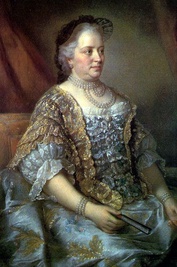
Maria Theresa
She was the only female ruler of the Habsburg dynasty and a very noteworthy woman. She took power in a difficult time and was under pressure from all sides but successfully withstood many.
She was the eldest daughter of Charles VI and took over power after her father’s death on the 20th of October 1740 thanks to the Pragmatic Sanction, which stipulated that the lands of the House of Habsburg were indivisible and that the successor to the throne was to be the first-born in the male or female line.
The situation she inherited was a bit dreary. Unsuccessful wars had dried out the coffers of the economically underdeveloped monarchy and had subverted the army. There was also a lack of strong leaders in the army and in the political management of the Empire. Right from the first days and weeks of Maria Theresa’s reign, it became clear that the incredible efforts exerted by Charles VI for the international recognition of the Pragmatic Sanction had been useless. Charles Albert, Prince of Bavaria, who was married to one of the daughters of Emperor Joseph I, laid claims to the Czech and the Austrian lands and didn’t recognize Maria Theresa’s rights to succession. The King of Prussia Fridrich II requested the resignation of several principalities in Silesia and when Maria Theresa refused to comply, he invaded Silesia in December of 1740. Spain laid claims to Lombardy. Albert obtained the support of France and of other States and in the fall of 1741, Bavarian, French and Saxon troops penetrated Bohemia. Maria Theresa’s only remaining ally was the hesitant England. So during the 8 first years of her reign, the young ruler had to dedicate her time to war issues. In the course of the long string
of conflicts known as the War of the Austrian Succession, she lost almost all of Silesia (except for the Cieszyn region, part of the Opava region, the Krnov region and the Nisko region) and some smaller territories in Italy. But she came out victorious in what was the most important – she gained the right to govern in the monarchy. After the death of Charles Albert, she pressed the election of her husband Francis Stephen of Lorraine to the throne of Holy Roman Emperor (1745).
Maria Theresa displayed admirable energy, determination and courage during these difficult times. With years, the graceful fair-haired woman put on weight, which supposedly added “dignified majesty to her beauty”.
These conflicts, as well as the later Seven Years War against Prussia, which ended with an absolute economic depletion on both sides and buried any hopes of recovering Silesia, convinced Maria Theresa that the Habsburg empire was underdeveloped. The ruler understood that if she didn’t rapidly deal with this problem, it would soon become impossible to preserve the traditional power position of the monarchy in Europe. And since the preservation of the dynasty’s power had always been the main subject matter of her deeds, she started modernizing the empire. Her rule was hence marked by vast reforms in all fields. It was the beginning of the so-called enlightened absolutism in Austria, which is a system of governance when essential reforms for the development of society are implemented from the top, by an enlightened ruler, through the State. Thanks to the reforms, the Habsburg conglomerate of very dissimilar countries soon became a modern centralized State, well-adapted to the enlightened century.











